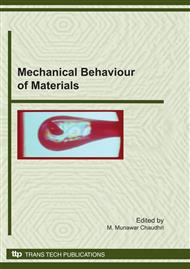p.1
p.13
p.27
p.39
p.53
p.77
p.85
p.95
Effect of Surface Roughness on the Adhesion of Elastomers to Hard Surfaces
Abstract:
The work presented started with the aim of trying to explain why clean smooth surfaces of materials such as metals brought gently into contact show no adhesion. The observation by Johnson Kendall & Roberts of adhesion between smooth surfaces of an elastomeric hemisphere and a rigid substrate suggested a model contact system with which the effect of surface roughness could be investigated experimentally. Moreover the Johnson-Kendal-Roberts (JKR) contact theory could be used to predict the effect of roughness on adhesion. The observations and predictions obtained are compared, and the implications for the contact of two rigid materials outlined. The limitations of the validity of the predictions are mentioned. Further studies of the adhesion to rough surfaces, in particular the phenomenon of enhanced adhesion at low roughness, will be discussed. Finally, more recent theoretical work is briefly referred to.
Info:
Periodical:
Pages:
39-51
Citation:
Online since:
November 2010
Authors:
Price:
Сopyright:
© 2011 Trans Tech Publications Ltd. All Rights Reserved
Share:
Citation:


